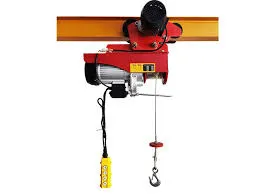


Types of Electric Winches
Electric winches are powerful devices used in various industries, enabling the lifting, pulling, and towing of heavy loads. These machines come in different types, tailored to specific applications, making them indispensable in sectors such as construction, agriculture, marine, and automotive. Understanding the different types of electric winches and their functionalities can help users choose the right equipment for their particular needs.
1. Portable Electric Winches
Portable electric winches are designed for ease of transport and versatility. These winches are lightweight and often feature a compact design, making them suitable for applications where mobility is crucial. They typically have a lower weight capacity, ranging from 1,000 to 3,000 pounds, making them ideal for light to medium-duty tasks such as pulling vehicles or moving equipment within a limited area. Users appreciate their convenience in construction sites, boating environments, and events where quick setups are required.
2. Industrial Electric Winches
In contrast to portable winches, industrial electric winches are built for heavy-duty operations. These winches can handle substantial loads, often exceeding 10,000 pounds. They are widely used in manufacturing, shipping, and large construction projects. The construction of industrial winches usually involves robust materials and advanced gearing systems to ensure durability and efficiency under extreme conditions. Moreover, they often come equipped with safety features such as overload protection and automatic shutoff systems to prevent accidents.
3. Electric Towing Winches

Electric towing winches are specifically designed for towing and recovery applications, particularly in the automotive and marine industries. These winches are commonly mounted on vehicles or trailers and are essential for recovering stuck vehicles, trailers, or boats. Typically featuring a high line pull, they can easily handle weights ranging from 3,000 to 12,000 pounds, depending on the model. Many towing winches also include a remote control for ease of use, allowing operators to control the winch from a safe distance.
4. Construction Winches
In the construction industry, specialized electric winches are used for lifting heavy materials such as steel beams, concrete blocks, and other equipment. Construction winches often have elevated load capacities and come with features designed for repetitive lifting tasks. They may include hooks, pulleys, and other accessories that enhance functionality. These winches are typically mounted on cranes or scaffolding, providing the necessary power to lift and position heavy loads accurately.
5. Boat Winches
Electric boat winches, also known as anchor winches, are indispensable for maritime operations. They are specifically designed to assist in anchoring or mooring boats and yachts. These winches are built to withstand corrosive marine environments and typically feature strong, waterproof casings. The pulling power for marine winches can vary significantly, with larger models capable of hoisting heavy anchors and chains, while smaller models are suitable for pleasure crafts.
Conclusion
Choosing the right electric winch involves understanding the specific application, load requirements, and operating conditions. Each type of electric winch has unique features that cater to different industries, ensuring that tasks ranging from light lifting to heavy towing are executed safely and efficiently. Whether you need a portable model for occasional use or a robust industrial winch for intensive operations, the right electric winch can significantly enhance productivity while ensuring safety and reliability in the workplace.



